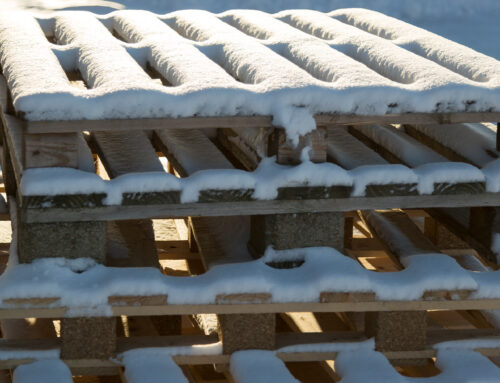For the average person, lumber tariffs are probably the last thing you’d think about when looking at the increased price of wood at the local hardware store. On the other hand, those of us that deal with industrial wood products, like pallets or crates, on a day-to-day basis know just how much effect lumber tariffs can have not only on pricing but on availability as well.
When talking about current industrial wood prices and availability in North America, tariffs definitely deserve a seat at the table. Between Mexico, Canada, and the United States, the three largest lumber suppliers on the continent, lumber tariffs levied against one another have massive implications for manufacturers, home builders, and consumers in North America.
In order to fully understand what the heck is going on with industrial wood prices these days, businesses and consumers alike need to understand what exactly tariffs are, the history of lumber tariffs in North America, and the current, and slightly dramatic, lumber tariff situation happening between Canada and the United States.
What’s a Tariff?
Chances are, economics wasn’t your favorite subject in school (If it was, 1: we commend you because economics is no fun, and 2: you can probably skip this section). So, now that those people are gone, let’s talk tariffs. According to Merriam-Webster, tariffs are “a schedule of duties imposed by a government on imported or in some countries exported goods.”
In laymen’s terms, tariffs are essentially a tax on goods levied by one country onto another. This can be done to either stimulate a specific industry in a country or, in some cases, economically punish another country.
One of the most ever-present and identifiable tariffs can be seen in the prices of foreign vehicles in the United States. For instance, the reason seeing a BMW in your neighbor’s driveway is far more eyebrow-raising than seeing a Chevy is because of tariffs. The United States currently has an auto tariff on European-made vehicles, forcing European car companies to raise their price in the US.
Now that tariffs are understood, let’s talk about what we’re here for – industrial wood.
Lumber Tariffs Yesterday and Today
In North America, the lumber industry is one of our oldest continuing industries. From colonial times to today, lumbermen, mill workers, craftsmen, and (after the industrial revolution) manufacturers have benefited from the vast forests of North America.
Almost as soon as it was founded, the United States started to enforce lumber tariffs to help fund the newborn nation’s government. The US continues this practice today because lumber tariffs, even after almost 250 years, continue to be a big money-maker for the United States federal government.
In recent years though, lumber tariffs have started having more and more effect on prices of industrial wood at the detriment of those that buy it. Well, why is this?
As the world has become a more interconnected and modern place, sawmills have become fewer, much larger, and more efficient. Although efficiency has drastically increased, so has demand for wood. With millions of manufacturers and homebuilders (and fewer forests), the North American lumber and industrial wood suppliers are more connected now than ever before.
With millions of manufacturers and homebuilders, North American lumber and industrial wood suppliers are more connected now than ever before. Click To TweetBecause of this connection, organizations like the North American Wholesale Lumber Association (NAWLA) have been founded to facilitate and regulate its constituents across the continent. Although organizations like NAWLA help to assess the health of the lumber industry in North America, countries still have the right to levy lumber tariffs that can help or harm aspects of the lumber industry.
Wood’s Wild Ride in 2020-2021
Currently, the United States has levied a 9% lumber tariff on Canada. Under normal circumstances, this would be considered general protection of the American lumber and industrial wood industries, but then the pandemic happened.
With COVID affecting the world, many sawmills and manufacturers were forced to shut down their operations for most of 2020 and part of 2021. Without the ability to process industrial wood (there were other factors too), wood products everywhere became scarce and pricey. To add to the problem, Canadian sawmills and manufacturers closed their doors as well, but for a longer period of time due to different government regulations and policies.
With a labor shortage and fewer workers in the mills, factories, and plants, along with the American tariff, Canadian lumber suppliers have had to drastically increase the price of their wood over the last year.
Along with all of this, demand in both countries has continued to rise. To top it off, Canada’s British Columbia, a large supplier of lumber, is currently experiencing wildfires that have destroyed millions of acres of forest, further decreasing the supply of Canadian lumber, and increasing its price.
Between the 9% lumber tariff, labor shortages on either side of the border, and gargantuan wildfires, American buyers have seen a drastic price increase in industrial wood no matter where they find it.
What’s Happening Now?
The tariff on Canadian lumber continues to affect the price of industrial wood across the nation. With the continued COVID craziness progressing in North America, it will definitely be interesting to see what the future holds for industrial wood. Currently, American lawmakers are at a point of contention in Congress on whether or not to lift the tariff of Canadian lumber. Only time will tell when, and if, this tariff will be lifted.
With the combined knowledge of what tariffs are, the history of lumber tariffs in the United States, and the current situation with Canada, all of this information paints an interesting picture as to how lumber tariffs, and other events, affect industrial wood prices.







